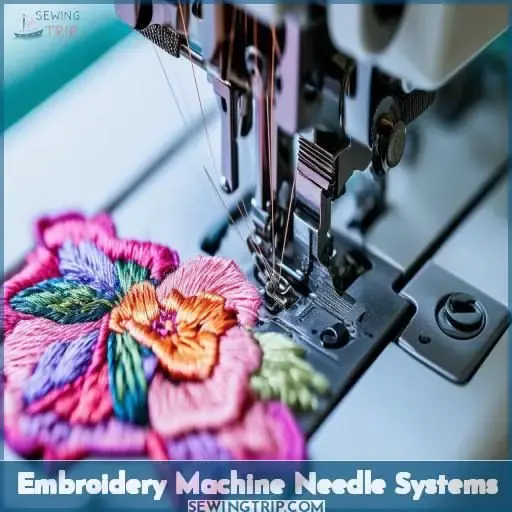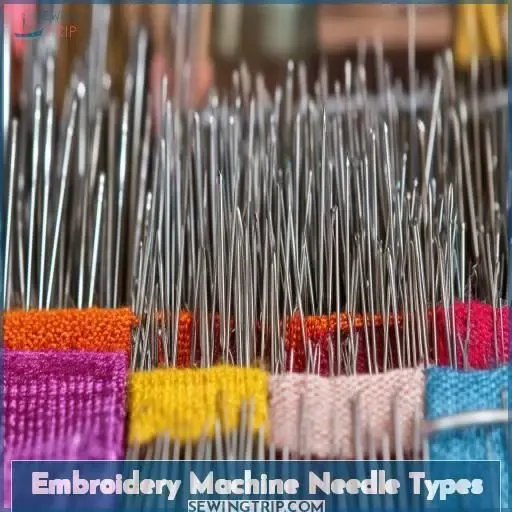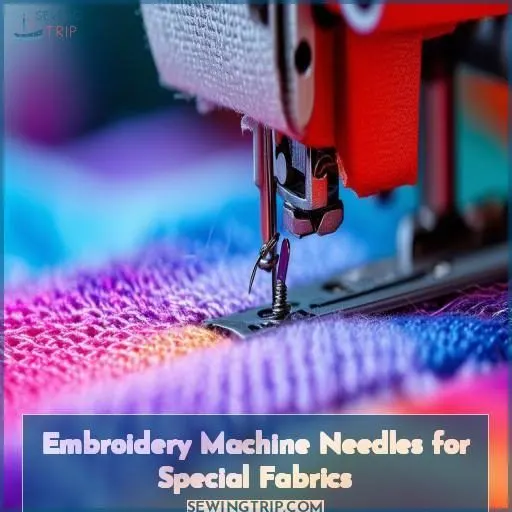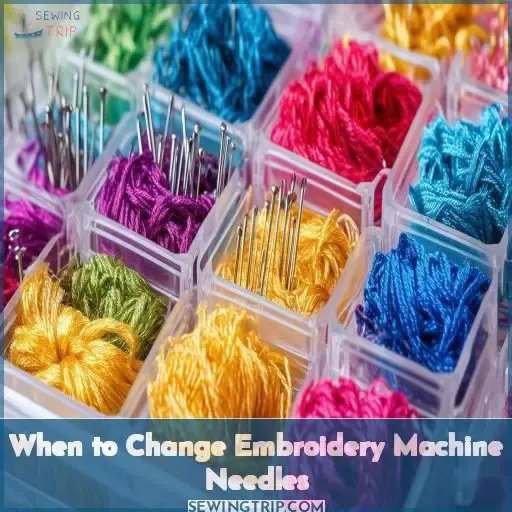This site is supported by our readers. We may earn a commission, at no cost to you, if you purchase through links.
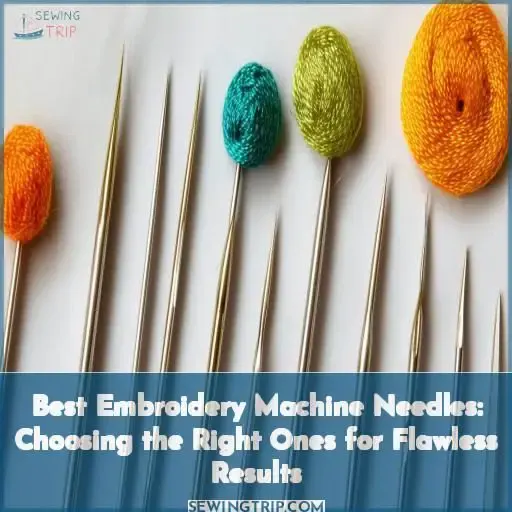 For flawless embroidery, choose the best embroidery machine needles suited to your project.
For flawless embroidery, choose the best embroidery machine needles suited to your project.
Sharp needles cleanly pierce woven fabrics. Ballpoints prevent runs in knits.
Light ballpoints handle delicates. Medium tackle fleece and t-shirts. Heavies excel with dense sweaters.
Metallic threads need larger-eyed needles for smooth threading.
Leather requires wedge or sharp points.
Check needle charts—sizing differs between European and Singer systems.
Replace dulled needles every few million stitches or days of heavy use to secure quality.
Tracking needle changes ensures you don’t unknowingly use the wrong type.
Learn more about selecting needles and you’ll elevate your stitchwork.
Table Of Contents
Key Takeaways
- Treat your embroidery needles like tiny warriors – each one is meticulously designed for specific fabric battles. The right fit unleashes flawless stitchery upon your canvas!
- Don’t be a one-needle soldier! Keep an arsenal of sharp, ballpoint, and specialty needles at the ready. That way, you’re always equipped to conquer any fabric, from delicate chiffon to burly denim.
- Dull needles are the sworn enemy of pristine embroidery. These traitors will leave your designs frayed and frazzled. Stay vigilant – routinely swap out aging needles for fresh recruits.
- Embroidery is an art form, and your needles are the brushes. With diligent care and the right tools for each project, your stitched masterpieces will dazzle like a finely tuned orchestra!
Embroidery Machine Needle Systems
When selecting embroidery machine needles, you’ll encounter different systems like the European (metric blade size), Singer (nominal number), DBxK5 (large elongated eye), and 16×257 (smaller eye, stronger). Understanding these systems is essential for achieving flawless embroidery results on various fabric types.
European System
In the European system, needle size corresponds to the metric size of the blade width. This international standard guarantees needle compatibility across machines and fabrics. The key benefits include:
- Precise sizing
- Consistent stitching quality
- Reduced fabric damage
- Easy needle identification
With the European system’s clear metric sizing, you can confidently choose the right needle for flawless embroidery every time.
Singer System
Unlike metric sizing, the Singer system uses nominal numbers to identify needle sizes. You’ll find the right fit easier with these tips:
- Check the needle size chart for fabric compatibility
- Test a few sizes – the right one pierces cleanly
- Store various sizes neatly for quick swaps
- Change needles regularly for sharp, skip-free results
Properly sized needles make all the difference for flawless embroidery.
DBxK5 System
Moving on, consider the DBxK5 system – needles with a large elongated eye, perfect for:
- Specialty threads like metallic or heavy toppers
- Working with thick fabrics or multiple layers
- Reducing friction and thread breakage
The pronounced eye shape offers advantages like:
- Less shredding and distortion
- Smoother stitching results
- Extended needle life
16×257 System
Another system is the 16×257, with a smaller eye but stronger needle. It’s designed for:
- Heavyweight fabrics
- Materials that fray easily
- Durable stitching
- Extended needle lifespan
While ballpoint needles are great for knits, the 16×257’s sharp point excels at cleanly penetrating woven fabrics without damaging them.
Embroidery Machine Needle Types
Regarding embroidery machine needles, you have multiple choices available, each tailored to specific fabric types and embroidery requirements. Sharp needles with their round points are ideal for piercing and stitching through woven fabrics, while ballpoint needles with their small rounded tips are better suited for knit materials as they separate the fibers instead of piercing through them.
Sharp Needles
Sharp embroidery needles with round points effortlessly pierce fabrics, thanks to their sleek shape. You’ll want these for:
- Woven fabrics like cotton or denim
- Tightly-woven materials requiring precision penetration
- Projects with dense stitch patterns
- Detailed designs on sturdy fabrics
With the right sharp needle, you can achieve clean stitches without fabric distortion.
Ballpoint Needles
You’ll need ballpoint needles for knit fabrics. They’ve a small rounded point that penetrates between fibers, preventing:
- Cutting or damaging the knits
- Skipped stitches
- Puckered embroidery
Select the right ballpoint based on fabric weight:
- Medium for t-shirts and fleece
- Heavy for sweaters and elastics
With proper needle sharpness, your embroidery will lay flat and look professional.
Light Ballpoints
For lightweight fine knits and sheer fabrics, light ballpoint needles are ideal. They gently separate fibers without damaging delicate materials. Light ballpoints feature:
- Slightly rounded point
- Small elongated eye
- Designed for light knits
- Prevent snagging, fraying, skipped stitches
These needles allow flawless embroidery on lightweight, drapey fabrics. Mastering when to use light ballpoints gives you control over beautiful results.
Medium Ballpoints
Perfect for embroidering fleeces, t-shirts, and sweatshirts, medium ballpoint needles feature:
- Rounded tips to penetrate knit fabrics
- Moderate strength for stability
- Carefully sized eyes for thread weights
- Decent durability for moderate use
Mastering medium ballpoints guarantees professional stitch quality on your everyday garments.
Heavy Ballpoints
Just like medium ballpoints, heavy ballpoints are ideal for knits. But they’re built for the most demanding projects:
- Thick sweaters
- Dense fleece
- Stretchy elastics
With a reinforced tip and sturdy shaft, heavy ballpoints maintain sharpness and strength through high-density fabrics. Ensuring proper needle-to-fabric compatibility extends needle lifespan and delivers flawless stitches.
Embroidery Machine Needles for Special Fabrics
When working with special fabrics like leather, metallic thread, or coated materials, selecting the correct embroidery machine needle is essential for achieving flawless results.
Wedge or sharp needles excel for leather.
DBx7ST or DBx9ST needles handle metallic threads beautifully.
Teflon or Cool Sew needles are ideal for coated fabrics.
Titanium needles offer long-lasting points.
Ballpoint needles work well for moisture-wicking knits, while sharp needles are better for wovens.
Leather
For leather, you’ll want sharp or wedge needles. These are designed to:
- Slice cleanly through thick, dense materials
- Reduce fraying and skipped stitches
- Maintain sharpness over extended use
- Create precise, professional embroidery
The right needle sharpness and shape confirm your leather projects look crisp, not ragged. With proper needle selection, embroidering on leather becomes a seamless, satisfying experience.
Metallic Thread
When embroidering with metallic thread, use a DBx7ST or DBx9ST needle. These needles feature:
- Larger eye size
- Special scarf coating
- Reinforced blade
- Chrome finish
The larger eye allows metallic threads to pass through smoothly, preventing shredding or breaking. Proper needle choice prevents damage to your designs and machine.
Coated Fabrics
When embroidering coated fabrics, you’ll want needles specifically designed to handle their slick surfaces:
- Teflon needles have a non-stick coating that glides through coated materials
- Cool Sew needles feature a specialized tip that prevents fabric buildup
- Both allow smooth penetration without snagging or skipped stitches
- Ideal for embroidering raincoats, outdoor gear, and other coated projects
Properly equipped, you can achieve professional results on even the trickiest coated textiles.
Titanium Needles
Along with specialty needles for materials like leather and metallic thread, titanium needles offer longer-lasting points for consistently sharp stitching. These needles are ideal when:
- Embroidering dense designs
- Working with multiple fabric layers
- Seeking maximum needle durability
- Prioritizing stitch quality
- Wanting extended point longevity
Titanium needles combine sharpness and resilience, ensuring your delicate and heavy-duty embroidery projects turn out flawlessly.
Moisture-Wicking Fabrics
For moisture-wicking fabrics, you’ll need to choose between:
- Ballpoint needles for knits – their rounded tips won’t split the fibers
- Sharp needles for woven fabrics – their pointed tips cleanly pierce through
- Opt for smaller sizes to avoid excess fabric damage
- Replace needles frequently to maintain excellent stitch quality
Getting the right needle size and type is essential for flawless embroidery on technical athletic wear.
When to Change Embroidery Machine Needles
Continuing our discussion on embroidery machine needles, let’s focus on when to change them for ideal results. Dull or damaged needles can lead to:
- Poor stitch quality
- Fabric damage
- Increased thread breaks
The general recommendation is to change your needle:
- Every 2 million stitches
- Every 8 hours of continuous use
- Every couple of days for large projects
However, the frequency depends on factors like fabric type, thread, and machine speed. It’s wise to inspect your needle regularly using a 10x loupe for signs of wear. Timely needle changes are preventive maintenance that optimizes stitch quality and prolongs machine life – a worthwhile investment for flawless embroidery.
Keeping Track of Embroidery Machine Needle Changes
To guarantee flawless embroidery results, you’ll want to diligently Track needle changes. Here’s how:
- Create a Needle Replacement Sheet for logging needle size, type, and change dates
- Tape this sheet somewhere visible, like the back of your machine
- Avoid using the wrong needles – they can damage fabric and thread
- Keep a variety of needles on hand for testing new materials
- Implement a digital tracking system with automated alerts for scheduled replacements
Maintaining the right needles is essential for high-quality embroidery. Think of it like an artist caring for their brushes – with proper maintenance, your "tools" will deliver pristine results every time.
Frequently Asked Questions (FAQs)
What are the most durable embroidery machine needles?
The strongest needles for embroidery are titanium needles – these tough warriors outlast standard needles, their sharpened tips slicing fabric with precision. For rigorous projects, they’ll be your dependable ally, ensuring flawless stitches stitch after stitch.
How do needle types affect embroidery quality?
Needle types greatly affect embroidery quality. Ballpoint needles produce smooth stitches on knits, while sharp needles create crisp designs on woven fabrics. Specialty needles like titanium or Teflon-coated yield clean embroidery on challenging materials like leather or coatings.
Can embroidery machine needles be reused or resharpened?
No, embroidery needles can’t be resharpened or reused. For best results, replace them regularly – approximately every 1-2 million stitches. Dull needles create thread breaks, uneven stitches, and fabric damage, so it’s important to use fresh, high-quality needles.
What causes embroidery machine needles to break frequently?
Embroidery needles break frequently due to incorrect needle size/type for the fabric, dull or damaged points, excessive thread tension, and sewing over dense areas. Inspect needles regularly and change them at the first sign of wear to prevent costly repairs.
Are there eco-friendly or sustainable embroidery machine needles?
You might consider titanium or chromium-plated needles – they’re more durable than standard steel needles and could potentially reduce waste from frequent replacements. However, truly eco-friendly options are still limited in the embroidery world.
Conclusion
Ironically, the humble embroidery needle plays a pivotal role in achieving flawless stitchwork.
By carefully selecting the best embroidery machine needles suited for your project, you’ll open up a world of polished embroidery.
Whether you’re working with knits, delicates, or dense fabrics, the right needle guarantees clean piercing and prevents unsightly runs.
Elevate your embroidery to new heights by tracking needle changes and harnessing the power of these tiny tools.

